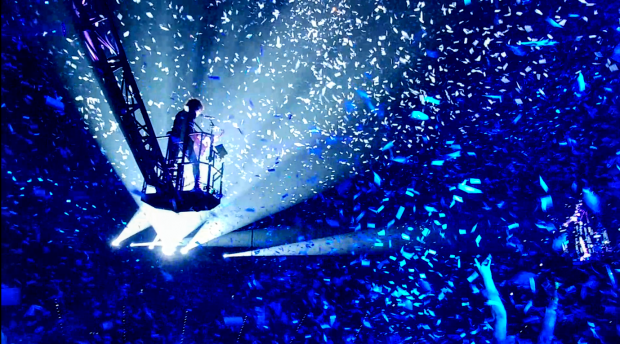I was brought up in a music-loving household.
Aside from the huge walnut radiogram in the front room, where crackling old 45s from Elvis or Buddy Holly were played, my Dad also had a National Panasonic SG-2080L Music Centre he kept for best. It was on this beauty I honed my love of hard rock music. The first purchase I ever dropped the needle on was a clear vinyl EP by Black Sabbath.
Little did I know I was headed for a musical epiphany (or lobotomy, depending on your point of view). In October 1983 I travelled to Cardiff with my mum to buy a record I wanted. It wasn’t in stock, but I was offered the new KISS album - presumably on the erroneous supposition that all long haired rock bands ‘sound the same’. As it turned out, the sound was unlike anything I’d ever heard before.
With the infamous image of black leather, platform boots and kabuki-style make-up, KISS emerged from the New York club scene in 1973. By the end of the year they’d attracted a manager, Bill Aucoin, who quickly secured them a recording deal. The band released their debut LP in early 1974.
The album was a commercial flop, as were subsequent releases. In concert, the band were gaining a following, but the reviews were often bruising.
KISS becomes a trademark
Even as early as mid-1974, the band’s management made an application for their hand-drawn KISS logo to be registered as a trademark with the US Patent and Trademark Office. By 1977, KISS was a consistent platinum record-selling act and, according to Gallup, America’s number 1 band.
KISS began to license their brand on a whole host of merchandise items; from make-up kits, jigsaws, radios and bubblegum cards. Even Marvel Comics got on-board with specially licensed KISS comic books. The band’s intellectual property was starting to make them money, outside of the record sales.

KISS and make-up
In 1978, realising the IP value of the band’s image, each member’s individual make-up design was classed as a trademark at the US Patent and Trademark Office. By 1979, the KISS brand was bringing in a reported $117 million through record sales, concert tickets and various licensed merchandise.
This was the band at the peak of its popularity. However, the early 1980s heralded a dramatic slide in fortunes as the band’s image became increasingly passé.
Their record label changed hands, the band split from their management and half the band had departed. Even the iconic make-up and outfits were dropped in 1983 in order to attract a new fan base – which is when I got on-board. Crucially, the group’s founding members Paul Stanley and Gene Simmons retained their IP rights, and later secured the image rights of the previous members’ make-up.
In 1996, sensing a shift in the musical landscape, the original group reformed, donned the make-up and heels and enjoyed a near sell-out 200 date world tour. The Alive/Worldwide tour grossed over $143 million and was the band’s most lucrative tour to date.
KISS becomes a licensing monolith
By protecting their original intellectual property – such as the trade marked logo, and trademarked make-up designs – the band’s founding members, Paul Stanley and Gene Simmons, are able to license its intellectual property as it sees fit. According to Simmons, the band’s name is now licensed to over 3,000 items.
To learn more about licensing IP, why not read our helpful guidance or watch our short video.

I recently spoke to Michael Brandvold, a music industry consultant, who has previously managed the online presence of KISS, Rod Stewart, Madonna and Ozzy Osborne. He advises his clients on their intellectual property:
Your intellectual property is your unseen product. If you don’t take time to protect it with something as simple and inexpensive as filing for a trademark, someone else can come along and take it. Musicians, for example, often think of IP as their music. But band names, given names, logos, and even tag lines also need to be seen as intellectual property. I’ve seen too many artists sign away the rights to their name as a domain name, never to get them back.
For 40 years KISS open every show with the refrain ‘You wanted the best, you got the best…’, and you’ve guessed it, they own that phrase as well.
I know, I’ve got the t-shirt.
To keep in touch, sign up to email updates from this blog, or follow us on Twitter.
2 comments
Comment by Tom posted on
Hi there, I love the blog and I am just wondering if I could ask a few questions regarding to IP?
1) What part of the IP spectrum would protect digital products? For examples ebooks, workbooks, mp3's, blog post etc? I know it would have some copyright qualities, but is there some other part of the IP spectrum that would protect these? And finally on this point, how would I go about protecting these items from the start of their production?
2) How can I transfer copyright ownership to a business. For example, if I drew some illustrations or put together an ebook, how could I transfer the ownership of the copyrights from me to a business?
3) Can copyrights be owned by one business and then used by another one? What I mean by this is say, an ebook owned by Company A then being exclusively used by Company B through their website etc? I have read about licensing but to be honest I am not 100% understanding how it works.
4) Similar to number 3 in that, can a trademark be owned by Company A but be exclusively used by Company B?
Thank you for your time.
Comment by Paula Davy posted on
Hi Tom
Great to hear you enjoy reading our blogs!
In order to provide a full response to each of your questions, are we able to respond to the email address we have for you? Alternatively, you may wish to email our information centre directly at information@ipo.gov.uk.
Many thanks
Paula